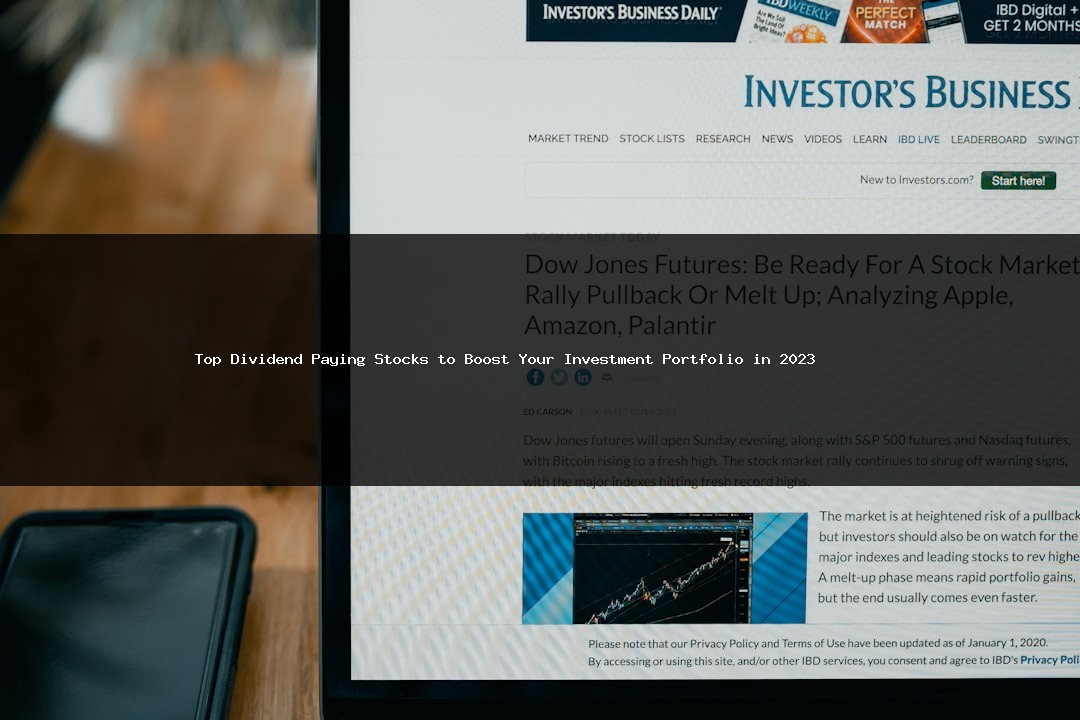In 2023, the financial landscape continues to evolve, and investors are seeking ways to enhance their portfolios with reliable income streams. One of the most effective strategies for achieving this goal is through investing in dividend-paying stocks. These stocks not only provide regular income but also have the potential for capital appreciation. In this article, we will explore the top dividend-paying stocks to consider for your investment portfolio in 2023, alongside an understanding of dividends, their benefits, and practical applications to maximize your investment strategy.
Understanding Dividend-Paying Stocks
Dividend-paying stocks are shares in companies that return a portion of their earnings to shareholders in the form of dividends. This practice is a sign of a company’s financial health, as it indicates that the company is generating sufficient profits to distribute to its investors. Understanding the mechanics of dividends is essential for any investor looking to build a robust portfolio.
What are Dividends?
A dividend is a payment made by a corporation to its shareholders, typically on a quarterly basis. These payments come from the company’s profits and can be issued in cash or additional shares of stock. Companies that consistently pay dividends are often viewed as stable and reliable, making them attractive to investors seeking income.
Types of Dividends
Dividends can be categorized into several types:
- Cash Dividends: The most common form of dividend, paid in cash directly to shareholders’ accounts.
- Stock Dividends: Additional shares given to shareholders instead of cash, which can increase the number of shares they own.
- Special Dividends: One-time payments that companies might issue when they have excess cash or extraordinary profits.
Dividend Yield
The dividend yield is a key metric for investors, calculated as the annual dividend payment divided by the stock’s current price. A higher yield can indicate a more attractive investment, but it is essential to consider the sustainability of the dividend as well.
Key Components of a Successful Dividend Investment Strategy
Investing in dividend-paying stocks requires a strategic approach. Several key components will help you identify the best opportunities in 2023.
Financial Health of the Company
Before investing in a dividend-paying stock, it’s crucial to evaluate the company’s financial health. Look for companies with strong balance sheets, consistent earnings growth, and a history of stable dividends. Key indicators include:
- Debt-to-Equity Ratio: A lower ratio generally indicates a company is not overly reliant on debt.
- Free Cash Flow: Positive free cash flow indicates that a company has enough cash to pay dividends.
- Earnings Stability: Consistent earnings over time can suggest a reliable dividend.
Dividend Growth History
Another important factor is the dividend growth history. Companies that have a history of increasing their dividends over time are often more reliable. Look for stocks that have increased their dividends for at least five consecutive years, as these are termed as “Dividend Aristocrats.”
Industry Trends
Understanding the industry in which a company operates can provide insights into its future dividend sustainability. Some sectors, such as utilities and consumer staples, are known for stable dividends due to consistent demand for their products and services. Researching industry trends will help you identify potential risks and opportunities.
Benefits and Importance of Dividend-Paying Stocks
Investing in dividend-paying stocks offers numerous benefits, making them an essential component of a balanced investment portfolio.
Steady Income Stream
One of the primary benefits of dividend-paying stocks is the steady income stream they provide. For investors, especially retirees, this income can be crucial for covering living expenses without having to sell shares.
Compounding Returns
Reinvesting dividends can lead to significant compounding returns over time. By reinvesting dividends into additional shares, investors can benefit from exponential growth, enhancing their overall investment returns.
Market Volatility Buffer
Dividend-paying stocks can act as a buffer during market volatility. While stock prices may fluctuate, the regular dividend payments can provide a level of stability and reduce the impact of market downturns.
Top Dividend-Paying Stocks to Consider in 2023
With a solid understanding of dividends and their benefits, let’s explore some of the top dividend-paying stocks to consider for your investment portfolio in 2023.
1. Johnson & Johnson (JNJ)
Johnson & Johnson is a leading healthcare company known for its strong dividend history. The company has increased its dividend for over 60 consecutive years, making it a reliable choice for income investors. With a current dividend yield of approximately 2.5%, JNJ offers both stability and growth potential.
2. Procter & Gamble (PG)
Procter & Gamble is another Dividend Aristocrat, boasting a long history of consistent dividend payments. With a diverse product portfolio and a strong market presence, PG has a current yield of around 2.4%. Its focus on consumer staples ensures steady demand, making it a solid investment choice.
3. Coca-Cola (KO)
Coca-Cola is a global leader in the beverage industry and has a remarkable history of dividend payments, having increased its dividend for over 59 years. The current yield stands at about 3.1%. Coca-Cola’s brand strength and global reach provide a reliable income stream.
4. 3M Company (MMM)
3M is known for its innovation and diverse product offerings. The company has a long-standing history of dividend payments, with a yield of approximately 4.3%. Its strong balance sheet and commitment to returning value to shareholders make it a compelling choice for investors.
5. Verizon Communications (VZ)
Verizon is a telecommunications giant that offers a high dividend yield of around 6.5%. Its consistent cash flow and essential services make it an attractive option for income-focused investors. Despite market fluctuations, Verizon’s strong dividend payments provide stability.
6. Realty Income Corporation (O)
Realty Income is known as “The Monthly Dividend Company.” It focuses on generating income from real estate investments and offers a monthly dividend yield of about 4.5%. Its stable cash flow from long-term leases makes it a popular choice among dividend investors.
7. PepsiCo (PEP)
PepsiCo, a leader in the food and beverage sector, has a strong dividend history, increasing its dividend for over 49 years. With a current yield of approximately 2.8%, PepsiCo’s diverse product range and strong brand recognition make it a reliable investment.
Practical Applications
To successfully incorporate dividend-paying stocks into your investment portfolio, consider the following practical tips:
Diversification
Diversifying your investments across various sectors can help mitigate risk. Consider investing in dividend stocks from different industries, such as healthcare, consumer goods, and utilities, to achieve a balanced portfolio.
Regular Monitoring
Keep an eye on your investments and monitor the companies’ financial health regularly. Changes in dividend policies, earnings reports, and market conditions can impact your investment decisions.
Reinvestment Strategies
Consider enrolling in a Dividend Reinvestment Plan (DRIP), which allows you to reinvest dividends automatically to purchase more shares. This strategy can enhance your returns over time through compounding.
Stay Informed
Stay updated on market trends, economic indicators, and company news that may affect your dividend-paying stocks. This knowledge can help you make informed decisions about buying or selling shares.
Frequently Asked Questions
What is a good dividend yield?
A good dividend yield typically ranges between 2% to 6%. However, the ideal yield can vary based on the investor’s goals and the industry in question. Higher yields may indicate greater risk, so it’s crucial to assess the company’s financial health and dividend sustainability.
Are dividend stocks safe to invest in?
While many dividend stocks are considered safe investments, no investment is entirely risk-free. Companies with a long history of stable dividends, strong financials, and a solid business model are generally seen as safer options. However, market conditions can impact even the most reliable dividend stocks.
How often are dividends paid?
Dividends are typically paid on a quarterly basis, but some companies may offer monthly or annual payments. It’s essential to check the specific schedule for each stock to understand when you can expect to receive your dividends.
Can I rely solely on dividend income for retirement?
While dividend income can be a significant component of retirement income, relying solely on it may not be advisable. A well-rounded retirement strategy should include a mix of income sources, such as pensions, savings, and investments, to ensure financial stability.
What happens to dividends during a recession?
During a recession, companies may face reduced revenues, leading them to cut or suspend dividend payments. However, companies with strong balance sheets and stable business models may continue to pay dividends. Investors should prioritize financially sound companies to minimize risks during economic downturns.
How do I choose the best dividend stocks?
To choose the best dividend stocks, consider factors such as the company’s financial health, dividend growth history, yield, industry stability, and overall market conditions. Conducting thorough research and due diligence will help you identify stocks that align with your investment goals.
Conclusion
Investing in dividend-paying stocks can significantly enhance your investment portfolio, providing a reliable income stream and potential for capital appreciation. In 2023, stocks like Johnson & Johnson, Procter & Gamble, and Coca-Cola stand out as excellent choices for income-focused investors. By understanding the key components of dividend investing and implementing practical strategies, you can build a robust portfolio that withstands market fluctuations. Remember to stay informed, diversify your investments, and regularly monitor your holdings to optimize your dividend income and overall investment success.





